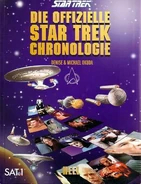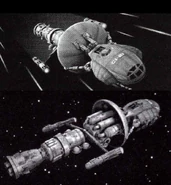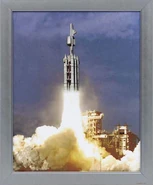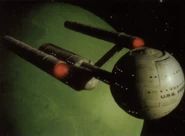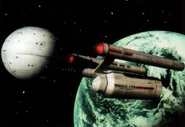Real world article
(written from a production point of view)
The Star Trek Chronology: The History of the Future is a reference book detailing the history of the Star Trek universe, written and compiled by production staffers Mike and Denise Okuda, and officially endorsed and licensed by Paramount. Despite being written from an in-universe perspective, it also is annotated with some real-world commentaries by the authors.
Summary[]
- From the 2nd edition back cover
- From the founding of the Federation, to Zefram Cochrane's invention of warp drive, to James T. Kirk's early days in Starfleet Academy®, to the voyages of the Starship Enterprise under Captain Jean-Luc Picard, to the newest adventures of the U.S.S. Voyager™, this book provides a comprehensive look at Star Trek's incredible history. The STAR TREK CHRONOLOGY documents every important event from every Star Trek episode and film, and includes both stardates and Earth calendar dates.
- An indispensable guide for Star Trek enthusiasts and writers alike, the STAR TREK CHRONOLOGY has been exhaustively researched and brought up to date by Star Trek production staff members Michael Okuda and Denise Okuda, and includes little-known "inside" information and trivia about the making of the hugely successful television shows and films.
- Profusely illustrated with more than 1,000 color photos – many never before printed anywhere – this is the one book that imparts every chapter in the exciting Star Trek saga. The STAR TREK CHRONOLOGY is an incredible journey through time and the future of Star Trek!
- Excerpts of copyrighted sources are included for review purposes only, without any intention of infringement.
Background information[]
- The first edition of the Chronology was published in black and white, and covered events up to TNG Season 5, while the second edition was published in full color, glossy paper throughout, and covered events up to DS9 Season 4 and VOY Season 2, with the 21st century events of Star Trek: First Contact also included.
- The extensive research the Okudas and Debbie Mirek were performing for the Chronology also formed the basis for the Star Trek Encyclopedia, the first edition of which was published a year later and therefore essentially a derivative work of the Chronology. Much of the interior artwork that was especially produced for this book would be reproduced in the Encyclopedia. Particularly noteworthy were the pictures of starships that were otherwise not seen on-screen in the franchise, serving to illustrate gaps in official Star Trek lore. The reference models of these ships were especially constructed to this end by Greg Jein, and included the Daedalus-class ("Greg modeled the Daedalus for us for the Star Trek Chronology", Okuda later confirmed [1](X)), the DY-100-class display model, the Bonaventure (C1-21), an Earth-Romulan War-era Romulan starship, [2](X) and the SS Valiant. [3](X) Excepting the Valiant and the Romulan ship, these eventually showed up on-screen as set dressing in the role of display models and were thus elevated to canon.
- Ed Miarecki had provided study models that were later featured as wreckage in "The Best of Both Worlds, Part II". Prior to their conversion into wrecks, Okuda himself had photographed both these, as well as Jein's models, for use in the Chronology, with Doug Drexler and Gary Hutzel Photoshopping them as they saw fit. [4]
- The Chronology was initiated by Gene Roddenberry when he was the executive producer of the first season of Star Trek: The Next Generation, as Mirek has clarified: "Roddenberry asked Mike to write up a chronology to keep the facts straight between TOS and TNG. I think at the time, he thought it would be about 7-10 pages of dates. Well, Mike (and Denise and ME) is a pathological overachiever. He felt to do the treatment justice, we would have to watch each episode and take notes… we ended up with about 10 pages of notes for EACH episode and the chronology was born." [5]
- Debbie Mirek served as a researcher, proofreader, and editor on the book and while acknowledged for it in the long list of acknowledgments in the Chronology itself, as well as in the Star Trek Encyclopedia, 1st ed., p. 397 in more detail, she was not officially credited for it.
- A popular, influential, and well received book, it saw at least one international release in the form of the 1999 German language edition, and the official Star Trek franchise has subsequently treated it, together with the Encyclopedia and the 1991 Star Trek: The Next Generation Technical Manual (co-written by Mike Okuda), as the sole primary quasi-canon sources for all subsequent in-universe reference works print publications, and requires licensed works of this kind, published since then, to be in concordance with the information contained within these three works, such as the later GE Fabbri and Haynes Publishing Star Trek publications. As a consequence, the franchise has officially debunked all previously licensed reference works written from an in-universe perspective (from which not a single piece of information was taken into account in either the Encyclopedia or the Chronology), most notably Franz Joseph's Star Fleet Technical Manual as well as Shane Johnson's Mr. Scott's Guide to the Enterprise and Worlds of the Federation. Labeled "unofficial", these works were de facto demoted by the franchise to the apocryphal status of novels, comics, non-production art (such as Star Trek: Ships of the Line calendars), and (computer) games. (Star Trek: The Magazine Volume 2, Issue 11, p. 71)
Galleries[]
Content gallery
Bonaventure (1st ed., pp. 18, 20)
SS Botany Bay, DY-100 class launch (2nd ed., p. 22)
USS Essex (2nd ed., p. 34)
USS Horizon (2nd ed., p. 35)
External link[]
- Star Trek Chronology at Memory Beta, the wiki for licensed Star Trek works


